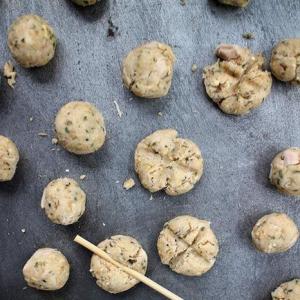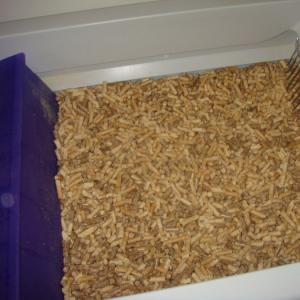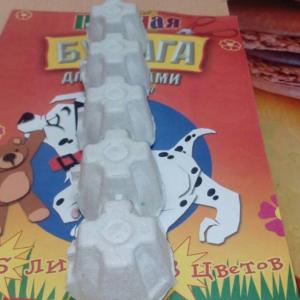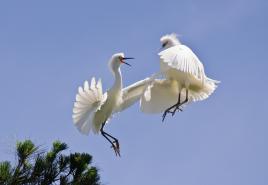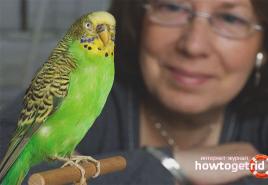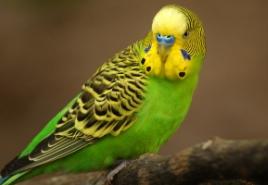My pet is a parrot. About the parrot. Where do parrots live
This is our pet - the budgerigar Ladushka. I was working, but she got bored and fell asleep. Last summer, my daughter and grandson saved a bird from a hurricane - exhausted, hungry, angry. We treated her and fattened her up. She stopped biting and is now affectionate. True, Skoda likes to hit her with her beak sometimes, but we forgive her everything. She has become smart. No, no, and he’ll put in a word, but everything is on topic.
- Oh, I woke up! Well hello! He's trying to figure out how to get closer to me! - Curious.

Budgerigars are not only green or blue in color with various shades, but also white - albinos, and yellow - lutinos.
Our bird's plumage was initially bright yellow, but its eyes were not, not red. Yeah, we think that means it’s not a lutinos, it should change in color. Indeed, it gradually began to turn green, and waves began to flow along the wings.
At first, when she was weak, she didn’t want to fly, and she didn’t understand why she needed it. I had to force it. Now she flies with great pleasure, easily and often. If you close the cage, he will get offended, get bored, or “yell” in an ugly way, so we don’t close it.
Ladushka loves to swim and splash, but more often when someone from the family is nearby and talks to her. You see, it’s not interesting. Viewers are needed.

The most surprising thing is how our bird behaves on weekend mornings, when we want to sleep longer. He wakes up and sits quietly, preens himself, and looks at us. Then he purrs like a cat and watches.
If there is no reaction, he waits silently. Only when it becomes completely unbearable will he tweet to check. And when the rise begins, he gives himself free rein. It lifts everyone's spirits - he sings in different modes, whistles, flies, sometimes gets in our way, tries to stick his “nose” in everywhere, wants to take part in everything.
And now, you see, it helps me. She decided to restore order, but couldn’t resist - she reached for the treat.
There was a time when we were breeding budgies, but we never had the goal of teaching them to “talk.” We were interested in something else. We observed their relationships: how they form pairs, how they relate to each other in pairs and to other birds, how they “build a family,” how they raise chicks. This is quite an exciting activity, I tell you. Especially if you breed them not for profit, but for the soul.
Of course, for this we built fairly spacious cages and good “houses” for nesting. And guess what? We saw an amazing picture. They are like people: some are loyal, caring, gentle - their couple never breaks up. And then there are the empty talkers: he chirped in the ear of one, flew to the other, and then forgot about that one. I'm talking about males.
I’ll also say about the females. Some are very caring towards their partner and offspring, others are not. It happened more than once that abandoned eggs had to be placed with more responsible parents.
And one more thing: our happiness knew no bounds when one of our couples had the most beautiful offspring, a very rare color - white with blue “snow”. Some chicks had more “snowflakes”, others had fewer. These “snowflakes” were different both in size and color. And the older the birds became, the more attractive they became. There were few of them in the offspring, but in size and beauty they surpassed all other birds that we had.
And now the video. Someone, just like us, loves these birds very much. Look, isn't this lovely?
The budgies with multi-colored “scarves” were also pleasing to the eye, but this is a separate topic.
Next time I will tell you about the rooster Petka - this is another one of our family. And you choose what kind of pet to get yourself, or tell us about the one you have.
Related materials:

Red kitten
Hello, my young readers! Some of you can't wait to continue the story about Darcy. And some adults have asked more than once how...

Mr Darcy is my kitten
We recently got a little kitten. My daughter, Natalya, dreamed of having a fluffy ginger cat for several years. And so, it happened. In the summer she outlined where...

And my daughter gave herself a sphinx
So my daughter Evgenia got her favorite pet. This is a cat, a Canadian Sphynx. My daughter bought herself a baby in Lugansk. Gave her...

Dormouse - blue squirrel
Miniature night squirrel. Continuing the topic of what pets can bring joy and warmth to you or your family, I want to tell you...
Stafievskaya Anastasia
Research project about the life of a pet.
Download:
Preview:
MBOU "Secondary school No. 91"
Research project
"My pet is a parrot"
Completed by: Stafievskaya Anastasia,
4a grade student
MBOU "Secondary School No. 91"
Head: Firsova Tatyana Nikolaevna,
primary school teacher
MBOU "Secondary School No. 91"
Novokuznetsk 2019
Introduction……………………………………………………………………………….. .. ..3
Chapter 1. Information about parrots…………………………………………………. .4
Chapter 2. Research, observations, experiments.
2.1 Creating conditions for a parrot to live at home……….......6
2.2 Parrot nutrition………………………………………………………. ..6
Practical part…………………………………………………………….. 7
Conclusion……………………………………………………………………. 8
Literature used and sources of information………………………..9
Appendix……………………………………………………………………………….10
Introduction
U I have a budgie named Kesha at home. He's funny and I love him very much. However, Kesha communicates little with me and is afraid of me. And I would like to make friends with my pet and teach him to talk. Therefore, I decided to learn more about parrots, the peculiarities of their maintenance, and also what is necessary for Kesha to learn to speak.
Research hypothesis:In order for your budgerigar to feel comfortable at home and learn to speak, you need to play with him more often.
Purpose of our research: learn to play with your pet.
Tasks :
1.From literature and Internet sources, find out what kind of parrots there are in nature.
2. Find out where my parrot’s homeland is and what conditions need to be created for him to feel at home.
3. Learn to take better care of my parrot so that he doesn't get sick.
4. Study what games he likes to play so that he is in a good mood, make a toy with your own hands.
5.Teach the parrot to talk so that it makes us happy.
Object of study:life of a parrot at home.
Subject of study: parrot Kesha.
Research methods:
- Study the literature on this topic.
- Conduct observations at home.
- Draw conclusions.
Chapter 1. Information about parrots
Millions of budgerigars with blue, yellow, green and motley colors live under the care of people. These birds were bred through selective breeding, resulting in mutations and bold new colors. The budgerigars that we keep as pets are more colorful and also heavier and slower than their wild relatives. They would not be able to survive in the natural conditions of Australia.
Parrots are funny birds. They can be happy, sad, sad, play and be cunning. Parrots can imitate humans. It was all these qualities that attracted the attention of man.
I have a budgerigar living at home, and I decided to observe him. Study the literature, find out how to properly care for it and thus conduct research about the life of budgies.
200 years ago people learned about the existence of these extravagant birds. Budgerigars, naturally, have earned popularity due to their appearance and character. They are easy to tame and very sociable. Budgerigars make life richer. Their positive effect on humans has been scientifically proven.
To properly care for your pet, you need to learn as much as possible about it.
Through the eyes of a budgie.
The bird's eyes are relatively large. They occupy 50% of the entire head, which suggests that the power of birds lies in their vision. Located on the sides of the head, the eyes give budgies a constant all-round vision. An enemy who approaches from behind hardly has a chance to remain unnoticed. The eyes can move independently of each other. Parrots see the world around them in color, just like humans.
The bird sees the big glass mainly when it is too late. Their spatial vision is poorly developed. Therefore, it is necessary to monitor when the bird flies.
Ears of a budgie.
Sounds of various tones - voices, ringing, singing, etc. - play a significant role in the world of budgies. Birds study sounds throughout their lives. Sounds play a significant role in communicating with a person. So it is not surprising that budgies hear well and can even imitate human speech.
Smell.
It is believed that birds do not smell. It still remains a mystery whether budgies can smell.
The beak of parrots is massive, short, a little like the beak of birds of prey, but much stronger and thicker. Parrots are very skilled at using it. The beak is both a device for capturing and chopping food and for climbing trees, and a very formidable weapon.
Parrots' legs are very strong, but rather short. Each paw has great independence of movement. In addition, the paws help to hold food, and they are also used by the bird to bring it to its beak.
And finally, the luxuriously rich color scheme of the plumage. The huge variety of color variations in the plumage of parrots is striking. However, the main color is green.
What does the body language of birds tell us?
Only clean plumage guarantees good flight; birds devote a lot of time to caring for their feathers every day. Unlike large parrots, budgies have a sebaceous gland. The fat secreted by the gland makes the feathers elastic and water-repellent. When grooming its plumage, a small bird often rubs its body in the area where the sebaceous gland is located and distributes the oil throughout the feathers. With pleasure she passes each feather through her beak.
- The smartest parrot is Jaco: he can learn from 300 to 500 words, the record is 800 words.
- The largest parrot on the planet is the hyacinth macaw, its size reaches 100 cm.
- The heaviest parrot is the Kakapo. Adult Kakapo weigh around 4 kg, with some specimens weighing up to 9 kg.
- Woodpecker parrots are the smallest species.
- It happens that parrots become so attached to people that they can be freed without fear.
- Parrots living in their natural environment cannot speak at all.
- Cockatoos, Grays, Amazons and Macaws live 60 - 80 years or more in captivity.
- Keas are predatory parrots that hunt sheep.
- The oldest parrot fossil was found in Denmark and is about 54 million years old.
- Parrots name their children.
- A parrot should sleep at least 10 hours.
- There is no leader in a flock of parrots. This is a union of equals.
Budgerigars are most often kept at home. These are very sociable birds, they are quite easy to keep, and they are easy to train.
The homeland of these birds is distant Australia. There they inhabit plains abundantly covered with grass. They usually build nests near water.
Budgerigars were brought from Australia to Europe approximately 170 years ago. In Russia, budgerigars began to be bred at the Moscow Zoo almost 80 years ago. Before this, they were not bred in Russia, but were imported from Western Europe. Currently, these birds are kept not only in zoos, but also by hobbyists in houses and apartments.
Why do many people love parrots?
Budgerigars are amazing and agile birds. Watching them is a great pleasure.
They greatly enliven the room, filling it with joyful, melodic sounds. Their chirping and chirping is pleasant and does not hurt the ears.
If you try really hard, you can teach him to speak. After all, this extraordinary bird can imitate various sounds, including copying human speech.
Chapter 2. Research,
observations, experiments
2.1 Creating living conditions for a parrot at home.
- The parrot loves warmth and sunlight, so his cage is in the brightest place in our house, but away from drafts. It is surrounded by green plants.
- The perches in the cage are made of twigs from different trees (linden, willow, cherry, pine, apple tree), because plastic ones make the birds' paws sore.
2.2 Parrot nutrition
- The parrot's main food is a mixture of different grains (millet, oats, rapeseed), which we buy at a pet store. We also add pieces of apples, bananas, pears, carrots, cherries and currants, and a boiled egg to the food. We secure pieces of fruit between the bars of the cage, this makes it easier for the birds to eat them.
- There should be clean sand or chalk in the cage; it is needed to “chew” food in the stomach.
- I read in a book that it is enough to give 1 tablespoon of grain feed during the day. At the same time, you need to add fresh vegetables and fruits to your parrot’s food every day. I also read some useful advice: in order for the parrot to eat cottage cheese and pureed fruit better, it is good to add semolina or crushed white crackers to them. It turns out that parrots do not like “wet” food.
- In winter and spring, it is very useful to add 3-4 drops of lemon juice to the water, which can be squeezed directly from the lemon - this disinfects the water and helps strengthen the feathers.
- In the magazine “Toshka” I learned that dandelion seeds and young leaves are a special treat.
Practical part
To prevent your budgerigar from getting bored, you need to play and talk with him every day, because boredom can make him sick.
Our Kesha has different toys: a swing, a bell, a hanging mirror, a basketball hoop with a ball. Various strings with beads. From time to time I change his toys to make it more fun for him. (Annex 1)
During our observations, I found out that most of all my parrot likes to play with the mirror and strings with beads.
In the Toshka magazine, I learned how to make toys for my pet myself. For example, a bell or a swing.
At home we keep the cage door open because our parrot gets tired of being in the cage and starts flying around the room. We close it only when the house is being cleaned, so as not to scare Kesha. Our parrot flies very quickly.
Kesha becomes more sociable when I play different songs on the computer, he immediately starts chirping happily. He greets my sisters and me with a joyful chirp when we return home. He likes it when we laugh, play and talk loudly. And we like to listen to his funny songs.
Parrots have an excellent memory, you can try to teach them to talk.
From the magazine "GEOlenok" I learned some rules on how to teach a parrot to speak:
- One person must teach the parrot;
- you need to teach every day and give treats;
- you need to start with words with hissing sounds; repeat them affectionately and clearly;
- During lessons, turn off the TV, radio and music.
My sister and I tried to teach Kesha to talk, but so far nothing has worked out for us. This requires a lot of time and patience. It turns out that the most important thing is not to scare him, not to make sudden movements, try to look after him and talk to him so that he is not afraid. When feeding your parrot, you must repeat his name all the time. Maybe the parrot will get used to it over time and pronounce it. The words and simple phrases that we want to teach him need to be pronounced appropriately. If everything doesn’t work out, you can’t be rude to your parrot or scream. Parrots have an excellent memory not only for words, they also remember insults for a long time. (Appendix 2)
Conclusion
In the course of my research (analysis of literature, materials from the global Internet, my own observations and practical actions), I learned:
- how best to care for my pet;
- what to feed him;
- what games does he like;
- how to teach him to talk.
Unfortunately, during my research, Kesha did not learn to speak. I learned that this is a long process that requires time and patience. I think the tips that I managed to find will help fulfill my dream and Kesha’s to learn to speak.
During practical work, we spent a lot of time with the parrot. We talked with him and played different games. My pet began to feel more comfortable in the house, willingly played with us, and was friendly. The games helped us establish contact with Kesha. The hypothesis was confirmed.
After I watched a video about parrots on the Internet, I was once again convinced of what unusual, talented birds they are and fell in love with them even more. I will definitely continue training my pet so that my pet can talk!
Many people keep different pets at home. The budgerigar is often seen. The description for children is detailed, with photographs to clearly explain what kind of bird it is. To keep it at home, it is important to know about the features of care, diet and many other equally important aspects of keeping it, which are slightly different, because parrots have different needs depending on the species.
Parrots are a class of parrot-like birds, consisting of one family Psittacidae and several subfamilies. They began to appear on Russian territory in the fifteenth century.
Description
Descriptions of each parrot individually differ, but all species have something in common. A characteristic feature of this bird is its bright coloring; most have long crests and tails. The majority of them fly well and climb trees. The parrot has four toes on each foot, which point forward and backward in pairs. Those species that fly poorly often have a greenish color to hide in the foliage. The beak, hook-shaped and sharp, allows the bird to chop food and defend itself, and during movement it is used as an additional support.
Parrots can weigh from tens of grams to one kilogram. Females are generally smaller than males. Life expectancy in the natural environment can be up to fifty years in certain species, but in captivity it practically does not exceed 35.
All parrots have a creaky, loud voice; a good memory gives them the ability to remember sounds and imitate others. In general terms, the description of the animal parrot turns out exactly like this.
Classification
Descriptions of the parrot include the modern classification. There are more than three hundred species, which are divided into five subfamilies:
- Loriaceae - small in size, bright color, unusual tongue structure;
- owls (terrestrial) - do not fly, some species smell of honey;
- woodpeckers - they have a high curved beak and a tail similar to a woodpecker;
- nestoridae are the most tame and frequently encountered feathered pets;
- real ones - the difference is a large hooked beak, the tail is long and narrow, some areas on the head do not have feather cover.
Due to human actions, many bird species are on the verge of extinction.

Parrot habitat
Parrots are birds that live in tropical and subtropical conditions. More than half of the species come from Australia, a third are from the countries of South and Central America, and a few representatives are found in Africa and the countries of South Asia. These birds do not live in the CIS under natural conditions.
As a rule, parrots live in forests, but can exist in steppe or mountain conditions. For housing, they prefer abandoned termite mounds, hollows or burrows. Collective way of life.
Nutrition
The diet of parrots includes various plant foods: fruits and vegetables, nuts, grains, berries, tree shoots. There are species of parrots that feed on pollen. Insects are consumed as protein food.
Reproduction
Before mating, birds go through a mating season. When they end, fertilization occurs. The female lays eggs, from two to nine, and incubates them. The male can also participate in this. The time the chicks appear depends on the species - from 18 days to 4 weeks.
Many people wonder what type of parrot is best to keep at home, but there is no clear answer. It all depends on your own desires.
Budgerigar
Before getting this pet for yourself or a child, the main thing is to understand whether it fits your lifestyle, character, behavior, etc. The main thing is to approach the question of describing the parrot in detail and thoroughly, since all the answers will be found there.

Together with the tail, the size of the parrot is from eighteen to twenty centimeters. Weight - about 40 grams. True natural color is green. The throat and face are yellow, there are purple and black spots on the cheeks. The back, back of the head and back of the head are colored with yellow-black waves. However, other colors are also available. They were obtained artificially by breeders.
On average, budgerigars live ten years, but there are also centenarians. According to various sources, the duration can reach a maximum of 20-25 years.
Budgerigars, among all the variety of birds, are the most common species of birds as pets. They have high intelligence, conversational abilities, and are quite easy to tame. In the description of the budgerigar it is worth including the fact that it is easier to maintain compared to others.
Care includes choosing a cage, its arrangement and place in the house, and one of the main conditions is the diet. The cage should be rectangular in shape, longer than tall. It is better for the rods to be horizontal. A drinking bowl and toys need to be installed inside the cage. But there should be enough free space for the parrot.

When getting a budgie, you need to consider what it will do in the absence of its owners. For these birds, communication is an important component. You can keep several birds. Every description of a parrot does not recommend keeping two girls.
Descriptions of the parrot allow you to understand whether the pet is suitable or not. After all, when adding a new tenant to your home, you need to be confident that all the necessary conditions for life will be created for him.
Parrot is a well-known bird that can be found both in the wild and as a popular pet. The scientific name of parrots is parrots (lat. Psittaciformes). The Psittacidae order is divided into two large families: Psittacidae and Cockatoo. Scientists know about 350 different species of parrots, 27 of which.
Appearance
A distinctive feature of most of the representatives of the order is their bright, variegated coloring with a predominance of rich green. Some species of these birds can reach up to a meter in length, and the smallest ones cannot exceed ten centimeters.
The most striking feature of the parrot order is a high, bent and sharp beak, vaguely reminiscent of the beaks of birds of prey. Such a beak is necessary so that the parrot can easily climb tree branches and crush hard fruits. Thick and short paws with curved claws and two toes turned back help the bird to hold on to branches and bring food to the beak. The parrot flies quickly, but prefers not very long distances.
Parrots are famous for their ability to memorize words and imitate various sounds, including human speech. These natural talents are explained by the fact that these birds have a fairly large brain and developed vocal cords.
Lifestyle
The natural habitat of parrots is warm countries. , these birds are also common in India, southeast Asia, South and Central America and.
As a rule, parrots live in trees. They can be found in forests, much less often they live in open spaces; some species live high in the mountains. Most parrots are active during the daytime.
The location of the nests is termite mounds, hollows, burrows. Some species nest on the ground. The number of eggs in a clutch is from 2 to 12 pieces. The chicks are born blind and naked.
The main type of food is fruits, various fruits, plant seeds. Parrots of the Loriidae family love to feast on nectar and pollen, thereby promoting the reproduction of various tropical plants. A flock of parrots can pose a serious threat to a garden. Also, these birds do not disdain insects and their larvae, as well as worms. Large parrots can eat carrion and, on occasion, can kill an adult sheep.
If this message was useful to you, I would be glad to see you
The message about the parrot will briefly tell you a lot of useful information about the birds that have become favorite pets and will help you prepare for the lesson.
A story about parrots
Parrots or parrots belong to a family of very popular animals, the class of birds. Parrots are distinguished by bright, multi-colored plumage: olive, brown, yellow, black, green. They are painted with all the colors of the rainbow. Birds can fly and quickly climb trees. The powerful beak serves as a tool for hollowing out hollows and obtaining food. It is also a formidable defensive weapon. Thus, an adult cockatoo can crush a person’s finger with one blow of its beak. In tree climbing, the beak acts as a third paw, with the help of which birds grab onto branches. In all parrots, the upper part, regardless of the lower part, can rise upward. But the lower part of the beak can move forward, backward, and to the sides.
At the end of the beak, parrots have transverse hard scars that help them crush and chew seeds and fruits. The tongue is muscular, with a depression at the end for capturing seeds.
Where do parrots live?
There are 324 species of parrots on the planet. They live in subtropical and tropical forests. They set up their nesting sites in noisy places not far from each other. Birds live in termite mounds, hollows, burrows and rock crevices.
What do parrots eat?
Basically, the diet of parrots consists of fruits, seeds, nuts, berries and insects.
Parrot breeding
After mating, the female lays 2-9 eggs in a clutch. The chicks hatch helpless, naked and blind. Parents do not leave their babies unattended for 2-3 months. They feed them with nutritious fluid from their crop until they fly.
Types of parrots
- Lori parrots. They are distinguished by a thick brush at the end of the tongue. They live in Australia and Indonesia.
- Jaco parrots. Birds perfectly imitate human speech and can remember more than 100 words.
- Budgerigars. They are an ornamental species of birds, as they live well in captivity.
- Kea parrots. They live in the mountains of New Zealand in areas with snow, fog and strong winds. This type of parrot often attacks sheep, as they love to eat meat.
- Macaw parrots. This is a genus of beautiful and large parrots that are common in Central and South America.
- Cockatoo parrots. They live in Australia.
- Amazon parrots. Their color is predominantly green. They are long-lived.
- Corella parrots. They are distinguished by their characteristic red cheeks and crest.
- Lovebird parrots. Widely distributed in southwest Africa. They create a pair for a long time, which is why they got their name.
- Ringed parrots. Habitat Africa and Asia. A distinctive feature is a long stepped tail.
- Some species of these birds are on the verge of extinction due to the fault of humans. The Seychelles, grass, kakapo, ground and Amazon parrots are included in the international Red Book.
- In Ancient Rome, a parrot was worth much more than a slave.
- Parrots can be left-handed or right-handed. You just have to pay attention to which paw the bird is trying to open the door in the cage and takes food.
- These birds have an excellent sense of rhythm and can dance to music.
- Some parrots love alcohol. In their natural habitat, they get it by eating fermented nuts and fruits.
We hope that the report about the parrot helped you prepare for the lesson, and you learned a lot of useful information about the family of popular animals. You can leave your story about the parrot using the comment form below.

